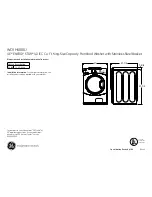
13 - ENG
1. Pull quick-connect coupler (E) back and insert nozzle (K).
6
k
E
2. Release quick-connect coupler and twist nozzle to make
sure it is secure in coupler.
WARNING: Flying object could cause risk of serious
injury. Ensure nozzle is completely inserted in quick-
connect socket and quick-connect collar is fully engaged
(forward) before squeezing gun trigger.
NOzzLE COLOR SPRAY PATTERN USES
SURFACES*
Red
0˚
powerful pinpoint
for spot cleaning
of hard, unpainted
surfaces or for
high reach areas
unpainted metal
or concrete;
DO NOT use on wood
Yellow
15˚
intense cleaning
of unpainted
hard surfaces
grills, driveways, concrete
or brick walkways,
unpainted brick or stucco
Green
25˚
standard cleaning
nozzle for most
applications
yard tools, sidewalks,
lawn furniture, unpainted
siding, stucco, gutters
and eaves, concrete,
brick surfaces
White
40˚
cleaning of
painted or delicate
surfaces
auto/RV, marine, wood,
painted brick and stucco,
vinyl, painted siding
Black
low pressure
applies cleaning
solutions
Low pressure
spray is safe on all
surfaces. Always verify
compatibility of cleaning
solution prior to use.
*NOTICE:
The high pressure spray from your pressure washer is capable of
causing damage to surfaces such as wood, glass, automobile paint, auto striping
and trim, and delicate objects such as flowers and shrubs. Before spraying, check
the item to be cleaned to assure yourself that it is strong enough to resist damage
from the force of the spray.
HOW TO APPLY CHEMICALS/CLEANING SOLvENTS (FIG. 7)
Applying chemicals or cleaning solvents is a low pressure operation.
NOTE:
Use
only soaps and chemicals designed for pressure washer use.
Do not use bleach.
To Apply Chemicals:
1. Ensure detergent siphon hose (F, Figure 7) is attached
f
7
to barbed fitting location near high pressure hose
connection of pump as shown.














































